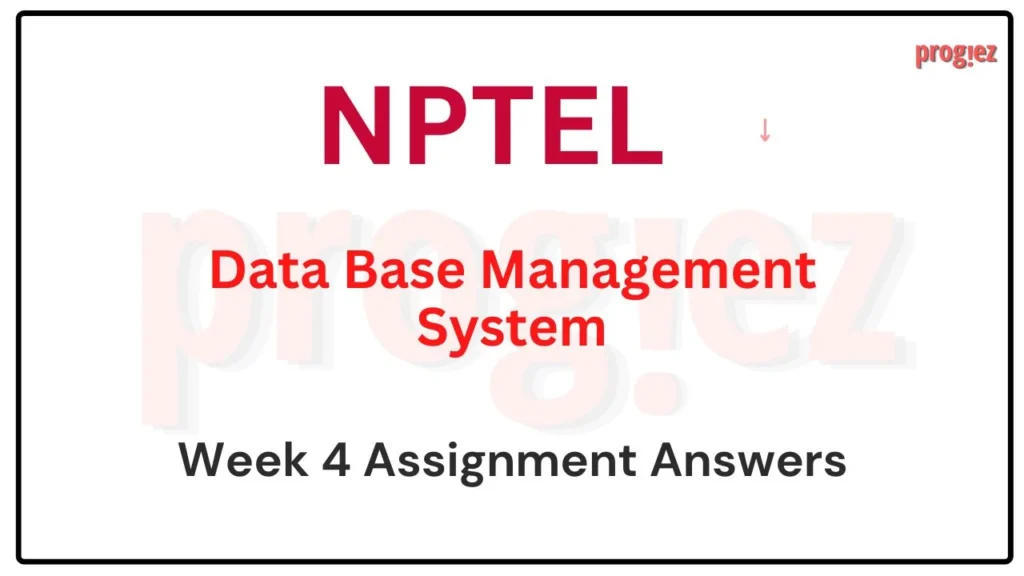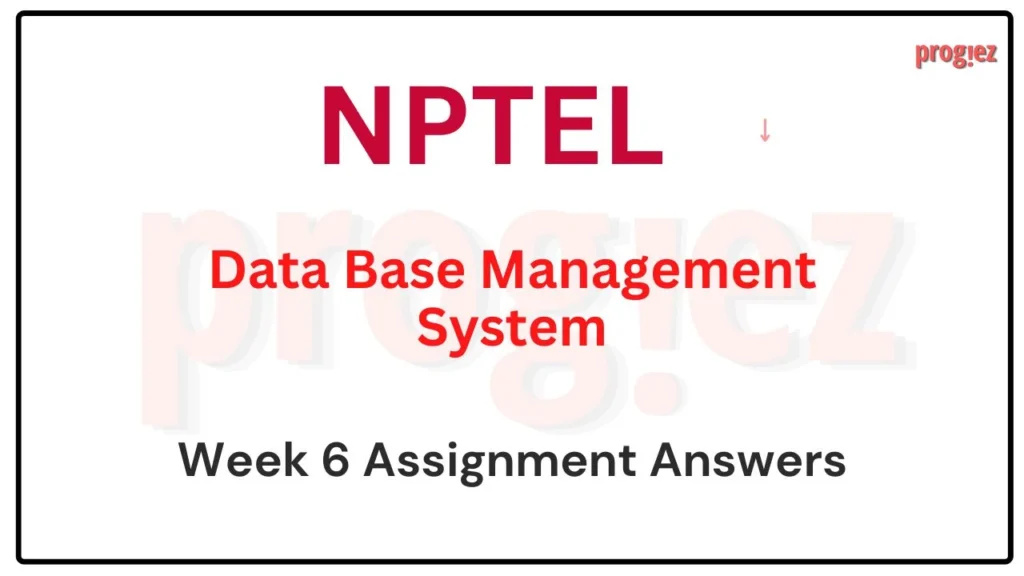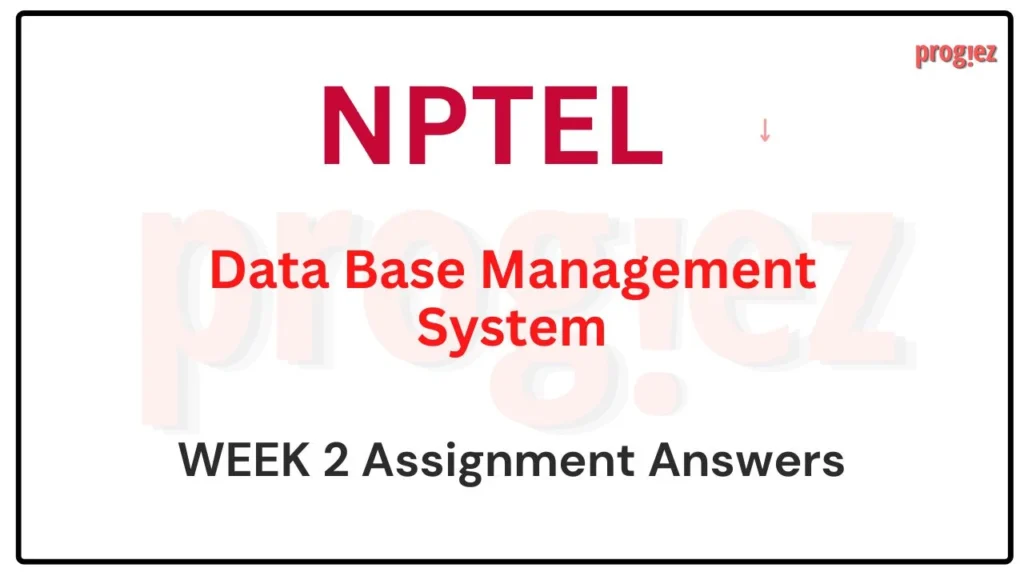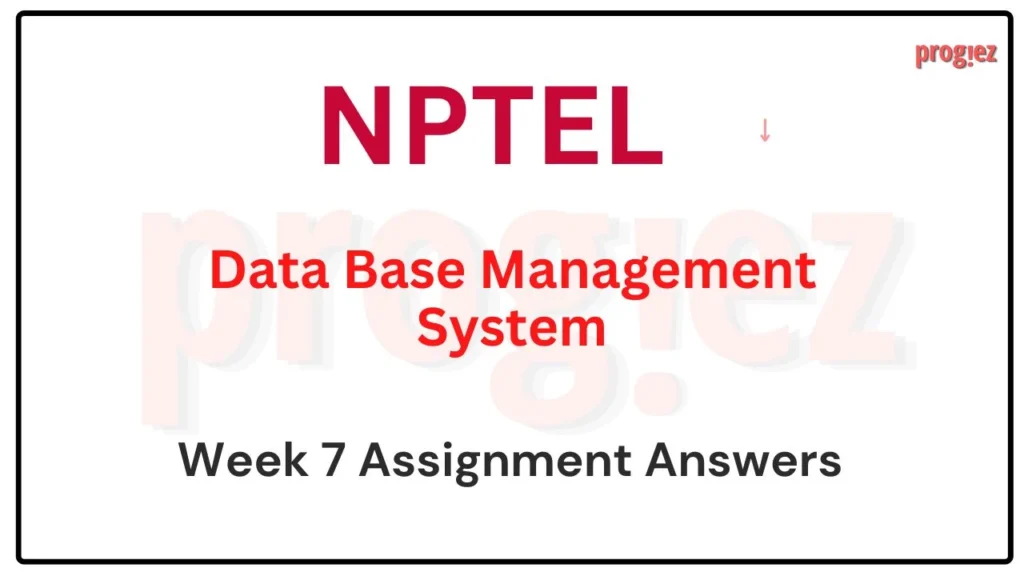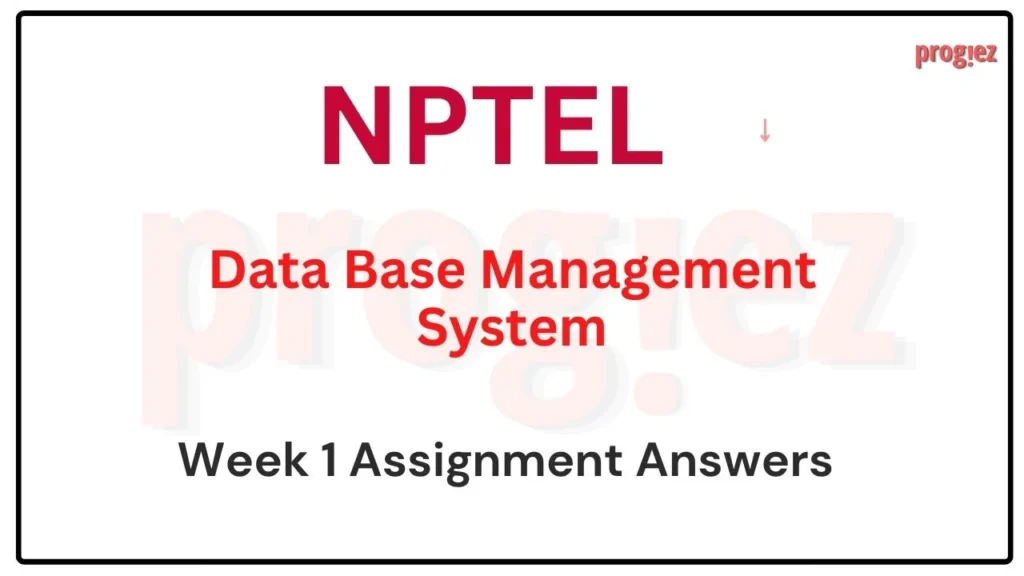Database Management System Nptel Assignment 5 Answer
Are you looking for the Nptel Database Management System Assignment 5 Answers? You’ve come to the right place! Our detailed and accurate solutions are designed to assist you in mastering the concepts of DBMS, including SQL queries, database design, normalization, and more.
Course Link: Click Here
Table of Contents
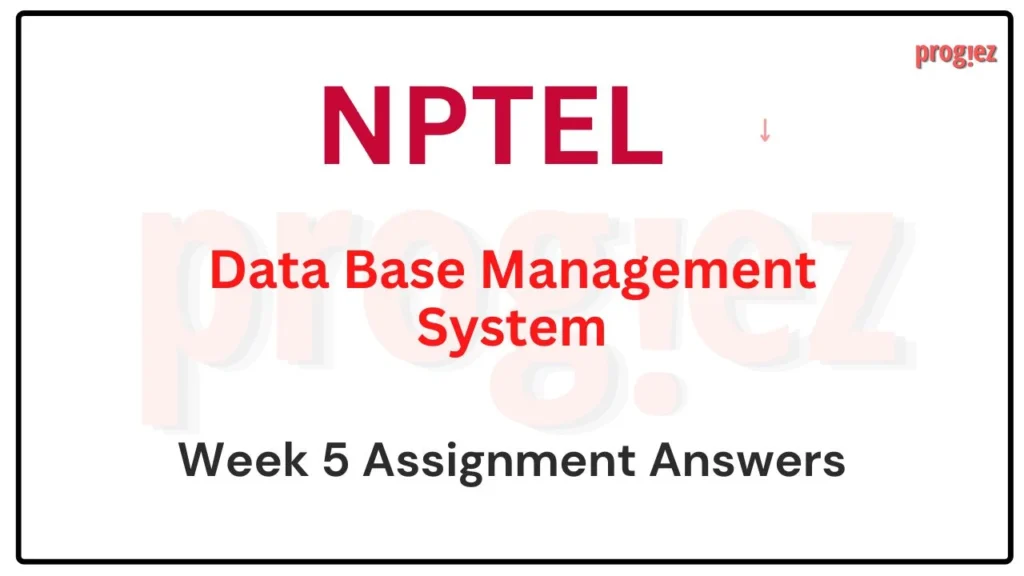
Nptel Database Management System Assignment 5 Answers (Jan-Apr 2025)
- Which of the following can be the solution(s) of Password Leakage in Database Servers?
a) Storing encrypted passwords in database and in scripts.
b) Reusing passwords across different sites.
c) Single-factor authentication using passwords.
d) Two-factor authentication (password plus one-time password sent by SMS).
View Answer
- Which of the following statement(s) is/are incorrect?
a) JavaScript is a Client-Side Scripting language.
b) World Wide Web is a language used for designing web pages.
c) Hyper Text Transfer Protocol is a connection-oriented protocol.
d) J2EE platform supports parallel processing.
View Answer
- A magnetic disk has 16 platter surfaces, 256 tracks per surface, 512 sectors per track, and 1024 bytes per sector. How many bits will be required to address a sector?
a) 17
b) 21
c) 27
d) 31
View Answer
- Consider the following table DEFAULTER (DID, NAME, AMOUNT). If we want to create an index on DID column, which type of indexing will be preferred?
| DID | NAME | AMOUNT |
|---|---|---|
| 415 | AISHA | 20000 |
| 124 | JOHN | 5000 |
| 347 | EDWARD | 100 |
| 145 | RAY | 200 |
| 209 | AKASH | 900 |
a) Sparse index
b) Secondary index
c) Dense index
d) Clustering index
View Answer
- Availability of Redundant Arrays of Independent Disks system is 97%. Mean Time Between Failure (MTBF) is 36 days. What is the approximate Mean Time To Repair (MTTR) of the system?
a) 10.80 Hours
b) 26.72 Hours
c) 34.92 Hours
d) 88.36 Hours
View Answer
- In a Coding Competition, participants individually enroll for the competition. There are many groups in the competition based on age. A participant can participate in only one group, and a group can consist of multiple participants. Each group has a unique name, and each participant has a unique ID. The result of each group is maintained separately. Which of the following statement(s) are correct?
a) Entity Group will not have any primary key.
b) Participate will be a one-to-many relationship between Group and Participants.
c) Participate will be a many-to-many relationship between Group and Participant.
d) Gname can be the foreign key of Participate relation between Group and Participant.
View Answer
- A flash storage system uses a page size of 4 KB and a 32-bit page-address for its operation. Moreover, the flash translation table is stored as an array. If the size of the flash memory is 64 GB, what will be the size of the flash translation table?
a) 64 MB
b) 32 MB
c) 24 MB
d) 16 MB
View Answer
- Consider the following string of reference: 12, 25, 31, 42, 12, 25, 50, 12, 25, 31, 42, 50. Find the number of replacements (where an existing value is replaced by a new value because the buffer is full) incurred using the least recently used (LRU) buffer replacement algorithm with 3 empty buffer frames.
a) 12
b) 10
View Answer
- Consider a file organization, where the size of one record is 48 bytes, the size of the disk block pointer is 10 bytes, and the size of one disk block is 512 bytes. If the organization of the file is sequential and unspanned (one block can store only whole records), what is the maximum number of records that can be stored in one block?
a) 12
b) 11
c) 10
View Answer
- Identify the correct statement(s) about the following RAID levels:
a) RAID 0 provides byte-level striping with mirroring.
b) RAID 1 provides disk mirroring without striping.
c) RAID 3 provides byte-level striping with dedicated parity checking.
d) RAID 5 provides Byte-level striping without parity bits.
View Answer
Nptel Database Management System Assignment 5 Answers (July-Dec 2024)
Q1‘Which of the following protocol(s) is used by a web server to communicate with external applications?
a) HTTP
b) SMTP
c) TCP/IP
d) CGI
Answer: d) CGI
Q2.In which way does an audit trail help to ensure the security of a system?
a) It is used to make backup copies.
b) It can be used to restore lost information.
¢) It can be used to localize the source of an error in a system.
d) It is used to record the history of operations performed on a file.
Answer: d) It is used to record the history of operations performed on a file.
For answers or latest updates join our telegram channel: Click here to join
These are Nptel Database Management System Assignment 5 Answers
Q3.Suppose, there is a disk with 200 sectors per track, size of one sector is 512 bytes and one
disk block unit is 4 kilobytes. What will be the access time of a single block unit if its average
seek time and rotational speed is 6 ms, and 12000 RPM. respectively, assuming the data rate
is 128 kilobytes per second?
a) 42.25 ms
b) 39.75 ms
c) 31.25 ms
d) 14.125 ms
Answer: b) 39.75 ms
Q4. If mean time to failure(MTTF) of a disk system is 60 days and it will take 20 hours to repair
the system. What is the availability of the disk system?
a) 13.80%
b) 75.1%
c) 98.63%
d) 100%
Answer: c) 98.63%
For answers or latest updates join our telegram channel: Click here to join
These are Nptel Database Management System Assignment 5 Answers
Q5Suppose there is a 256 gigabyte flash storage system, with a four kilobyte page size. What will
be the size of the page address if the flash translation table is 512 megabytes long, and the
table is stored as an array?
a) 128 bits
b) 64 bits
c) 32 bits
d) 16 bits
Answer: c) 32 bits
Q6.In an IoT demonstration competition, students can enroll their names as a team member.
There can be two or more members in a team but one member can enroll his/her name only for
one team. Each team has a unique id and name. Each member has a unique id and name too.
Which of the following way(s) is/are correct for storing the information of members and teams?
a) We may create one table Team with Tean_Id as primary key and a table Members with
Mem_Id as primary key. In the second table, column Team_Id will be added as a foreign key.
b) We may create one table Members with Mem Id as primary key and a table Team with
Team_Id as primary key. In the second table, column Mem_Id will be added as a foreign key.
c) No foreign key will be required only Members and Team table is enough.
d) It is not possible to store all required information in 2 tables.
Answer: a) We may create one table Team with Tean_Id as primary key and a table Members with
Mem_Id as primary key. In the second table, column Team_Id will be added as a foreign key.
For answers or latest updates join our telegram channel: Click here to join
These are Nptel Database Management System Assignment 5 Answers
Q7.Redundant Arrays of Independent Disks use the technique of redundancy to avoid data and
information loss in case of disk failure. Which of the following technique(s) is used for data
duplication?
a) Compressing
b) Interleaving
c) Striping
d) Mirroring
Answer: d) Mirroring
Q8.Suppose that a disk drive has 200 tracks, numbered 0 to 199. The queue of pending requests
in SSTF order is: 72, 122, 84, 175, 48, 150, 102, 181, 145.
The read-write head initially is on track 65. What is the total distance that the disk head
will move to satisfy all pending requests following Shortest Seek Time First (SSTF) scheduling
algorithms?
a) 538
b) 343
c) 249
d) 150
Answer: c) 249
For answers or latest updates join our telegram channel: Click here to join
These are Nptel Database Management System Assignment 5 Answers
Q9.Consider arelation course (c.id, dno, subject, cname, dname, semester, year, building)
c.id — cname, subject
dno — dname, building
c.id, subject — year, semester
If we perform a schema refinement on course, which of the following set of relations will be
in the refined schema?
a) courseDept(dno, dname, building)
course(c.id, subject, cname)
subject(subject, semester, year)
b) courseDept(dno, dname, building)
course(c_id, dno, subject, cname, semester, year)
c) courseDept(dno, dname, building)
course(c_id, subject, cname, semester, year)
d) courseDept(dno, dname, building)
course(c.id, cname, semester, year)
subject(subject, semester, year)
Answer: a) courseDept(dno, dname, building)course(c.id, subject, cname)subject(subject, semester, year)
Q10.Which of the following statement(s) is (are) correct? RB
a) The disk controller acts as an interface between the computer system and the disk drive |
hardware. |
b) Mean time to failure (MTTF) is the minimum time, when a disk can run continuously
without any failure.
¢) When a sector is found to be bad, the disk controller remaps the logical sector to a different |
physical sector. |
d) When a huge number of disks are connected by a high-speed network to a number of servers, |
is called Network Area Storage.
Answer: a) The disk controller acts as an interface between the computer system and the disk drive |
hardware. |
¢) When a sector is found to be bad, the disk controller remaps the logical sector to a different |
physical sector. |
For answers or latest updates join our telegram channel: Click here to join
These are Nptel Database Management System Assignment 5 Answers
All Weeks of Database Management System: Click here
For answers to additional Nptel courses, please refer to this link: Check here
Nptel Database Management System Assignment 5 Answers (Jan-Apr 2024)
Course Name: Data Base Management System
Course Link: Click Here
For answers or latest updates join our telegram channel: Click here to join
These are database management system nptel week 5 assignment answers
Q1. Choose the INCORRECT statement from the following.
a) Data Dictionary stores the information about schema definition.
b) Data Dictionary stores the information about Integrity constraints on a relation.
c) Data Dictionary does not store user and accounting information of a database.
d) Data Dictionary stores the information about file organization.
Answer: c) Data Dictionary does not store user and accounting information of a database.
Q2. The different Uniform Resources used to identify and locate Web resources in the Web are Uniform Resource Identifier(URI), Uniform Resource Locator (URL) and Uniform Resource Name(URN). Find the INCORRECT statement from the following regarding URI, URL and URN.
a) URI can either be a URN or URL or both.
b) URN identifies a Web resource by its name given in the namespace.
c) URL provides the functionality of pointer to locate a Web resource in the Web.
d) URL defines something’s identity, while URN provides a location.
Answer: d) URL defines something’s identity, while URN provides a location.
For answers or latest updates join our telegram channel: Click here to join
These are Data Base Management System Week 5 Assignment Answers
Q3. Consider a table which contains the salary of employees. A new salary of 15200 is inserted into this table after which the pointers are rearranged as shown in the figure. Which of the following file organizations is used to represent this?
a) Sequential File Organization.
b) Heap File Organization.
c) Multitable Clustering File Organization.
d) Hash File Organization.
Answer: a) Sequential File Organization.
Q4. If a disk system contains 1,600 disk drives, and each has a 4, 00, 000 hour MTBF (Mean time between failure), how often a drive failure will occur in that disk system?
a) 6400000 hours
b) 400000 hours
c) 400 hours
d) 250 hours
Answer: d) 250 hours
For answers or latest updates join our telegram channel: Click here to join
These are database management system nptel week 5 assignment answers
Q5. Consider a disk pack with the following specifications: 16 double-sided platters, 256 tracks per surface, 512 sectors per track and 1024 bytes per sector. Which of the following is the correct capacity of disk (approximately)?
a) 512 MB
b) 2 GB
c) 4 GB
d) 8 GB
Answer: c) 4 GB
For answers or latest updates join our telegram channel: Click here to join
These are database management system nptel week 5 assignment answers
Q6. If you want to design a secure database applications with large amounts of data and low update rate. Which of the following RAID level will you select?
a) RAID level 5
b) RAID level 3
c) RAID level 1
d) RAID level 0
Answer: a) RAID level 5
For answers or latest updates join our telegram channel: Click here to join
These are database management system nptel week 5 assignment answers
Q7. In a Cafe Shop, several types of food items are there. A customer places his/her order. A serviceman can serve multiple orders but an order will be serviced by only one serviceman. A customer can place more than one order. Which of the following statement(s) is (are) true?
a) There will be minimum three entities in the E-R diagram.
b) There will be minimum four entities in the E-R diagram.
c) Minimum two relationships will be required in the E-R diagram to modeled the scenario.
d) Minimum three relationships will be required in the E-R diagram to modeled the scenario.
Answer: b, c
For answers or latest updates join our telegram channel: Click here to join
These are Data Base Management System Week 5 Assignment Answers
Q8. Consider there is a sequential file for the relation Customer. The record size is fixed and the size of one record is 46 bytes. If the records do not cross block boundaries, and the disk block is 512 bytes with the block pointer size 10 bytes long, what is the maximum number of records can be stored in one block?
a) 9
b) 10
c) 11
d) 12
Answer: b) 10
For answers or latest updates join our telegram channel: Click here to join
These are Data Base Management System Week 5 Assignment Answers
Q9. An operating system uses the Least Recently Used (LRU) strategy for replacing its buffer. Suppose, the system allocates 3 free main memory buffer blocks for the execution of a query. If the query requires the following disk blocks to access to complete its execution:
2, 5, 3, 5, 4, 5, 3, 2, 9, 3, 5, 3, 1, 2
What will be the image of those 3 buffer blocks after servicing the disk block ‘9’?
a) 4 2 9
b) 9 5 3
c) 2 5 9
d) 2 9 3
Answer: d) 2 9 3
For answers or latest updates join our telegram channel: Click here to join
These are Data Base Management System Week 5 Assignment Answers
Q10. Which of the following statements are false about the Buffer Manager?
a) Programs call the buffer manager when they only need to transfer a block to disk.
b) If the block is already in the buffer, buffer manager will do nothing.
c) If the block is not in the buffer, the buffer manager allocates space in the buffer for the block.
d) For allocating the space, sometimes the buffer manager replace some other block also.
Answer: a, b
For answers or latest updates join our telegram channel: Click here to join
These are Data Base Management System Week 5 Assignment Answers
More Solutions of Data Base Management System: Click Here
More NPTEL Solutions: Click Here
Nptel Database Management System Assignment 5 Answers (July-Dec 2023)
Course Name: Data Base Management System
Course Link: Click Here
These are Data Base Management System Week 5 Assignment Answers
Q1. Which of the following can be the solution(s) for Password Leakage Problem in Database Servers?
a) Two-factor authentication (password plus one-time password sent by SMS).
b) Storing encrypted passwords in database and in scripts.
c) Using the same password across different sites.
d) Single-factor authentication using usernames and passwords.
Answer: a, b
These are Data Base Management System Week 5 Assignment Answers
Q2. In a file structure of Variable-Length Records, which of the following does a slotted page header contain?
a) block pointer
b) number of record entries
c) end of free space in the block
d) size of the next record
Answer: b, c
These are database management system nptel week 5 assignment answers
Q3. A file organization is sequential and unspanned (one block can store only whole records). The disk block size is 512 bytes. Each record of the file is 32 bytes long and the block pointer size is 12 bytes. How many records can be stored in one block?
a) 17
b) 16
c) 15
d) 14
Answer: c) 15
These are Data Base Management System Week 5 Assignment Answers
Q4. Suppose that the record of a book in a library is 300 bytes long. The details of the disk storage is as follows. The disk unit rotates at 7200 rpm (revolutions per minute). The data transfer rate of the disk is 75000 bytes per second whereas seek time is 20 milliseconds. One block contains 5 such records of the book. If a student asks to know the details of a given book, how much time will be required to know that?
a) Approx. 441 milliseconds
b) Approx. 44 milliseconds
c) Approx. 24 milliseconds.
d) Approx. 4 milliseconds
Answer: b) Approx. 44 milliseconds
These are Data Base Management System Week 5 Assignment Answers
Q5. What is the availability of a Database Management System having the following reliability parameters? Mean Time Between Failure (MTBF) = 36 days Mean Time to Repair (MTTR) = 18 hours
a) 20.01%
b) 64.25%
c) 97.95%
d) 99.02%
Answer: c) 97.95%
Q6. Suppose that a disk drive has 200 tracks, numbered 0 to 199. The queue of pending requests
in FIFO order is: 75, 142, 93, 177, 48, 150, 102, 171, 136.
The read-write head initially is on track 45. What is the total distance that the disk head will move to satisfy all pending requests following first cum first serve(FCFS) scheduling algo-rithms?
a) 563
b) 613
c) 633
d) 823
Answer: b) 613
These are database management system nptel week 5 assignment answers
Q7. Suppose that a Database Management System uses the Most Recently Used (MRU) strategy as its buffer replacement policy. Further, suppose that the system allocates 4 free buffer blocks for execution of a query to be used as a buffer. Assume that a query requires to access the following disk blocks in that order to complete its execution:
9,5,1,2,5,3,5,4,2,3,5,3,2,1,2,5,1,9,5,1
Calculate the number of block replacements (when all blocks are full, a residing block is replaced with a required block) required to complete the query.
a) 7
b) 8
c) 9
d) 10
Answer: a) 7
These are Data Base Management System Week 5 Assignment Answers
Q8. Consider the following statements:
1: Copy the required block from the disk to the main memory buffer.
2: The program calls the buffer manager for the required block.
3: Buffer manager returns the address of the block residing in main memory to the pro-gram.
4: Replace some other block, if the buffer blocks in main memory are not free.
There are a few statements written above. Arrange them in order to resolve what happens, when a program identifies that a required block is not available in the main memory buffer.
a) 2,3,1,4
b) 2,3,4,1
c) 24,31
d) 2,4,1,3
Answer: d) 2,4,1,3
These are database management system nptel week 5 assignment answers
Q9. Consider the following schema:
Member (Mid, Fname, Lname, Domain, Gender, Mobile_no, DOI)
Journal publication(DOI, J name, J_type, No_of publication, Mid) with the following functional dependencies:
Mid — Fname, Lname, Domain, Cender, Mobile_no
Mid — DOI
DOI — Mid
DOI—+ Jname, J_type, Noof publication
‘Which will be the refined optimal schema from the followings?
a) Member(Mid, Fname, Lname, Domain, Gender, Mobile.no, DOI)
Journal _publication(DOI, J.name, J_type, No_of publication, Mid)
Jounal 1ist(DOI, Mid)
b) Member(Mid, Fname, Lname, Domain, Gender, Mobile no)
Journal publication(DOI, J.name, J_type, No_of publication, Mid)
c) Member (Mid, Fname, Lname, Domain, Gender, Mobile no, DOI)
Journal publication(DOI, J.name, J_type, No_of publication)
Jounal 1list(DOI, Mid)
d) Member(Mid, Fname, Lname, Domain, Gender, Mobile no)
Journal publication(DOI, J.name, J_type, No_of publication)
Answer: d) Member(Mid, Fname, Lname, Domain, Gender, Mobile no)
Journal publication(DOI, J.name, J_type, No_of publication)
These are Data Base Management System Week 5 Assignment Answers
Q10. Suppose you have a 128-gigabyte flash storage system with a 2048-byte page size. How big would the flash translation table be, assuming each page has a 32-bit address, and the table is stored as an array?
a) 256 megabytes
b) 32 megabytes
c) 64 bytes
d) 32 bytes
Answer: b) 32 megabytes
These are Data Base Management System Week 5 Assignment Answers

